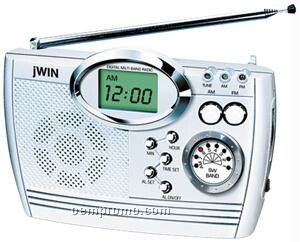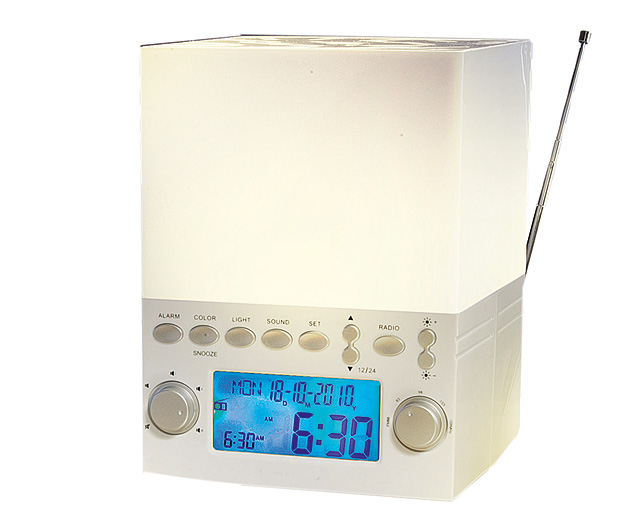

You might want to steer clear of dance and heavy rock, where everything starts to sound cluttered, but for easy background listening it’s fine. It doesn’t have the rich bass or warmth of the tiny Revival Petite, and some boxiness creeps in at higher volumes, but it’s clear and authoritative with news, sports, spoken word and drama programmes, and reasonably adept with music. Most importantly, the sound is great for the money. It’s quick to find and lock on to channels, and while the two-line LCD display doesn’t provide a lot of info, it does the job. This makes it extremely easy to use, particularly with the ability to store up to ten of your favourite stations just by pressing and holding the heart button. The design is equally simple, with a black or white plastic casing with a dark or light grey fabric cover at the front, and only two knobs and three buttons to handle volume, tuning and presets.
Best sound quality alarm clock radio portable#
It’s a compact portable model, powered by four AA batteries or a USB-C cable, and there’s no Bluetooth connectivity or additional modes beyond DAB and FM radio. The Play 11 is Roberts’ most basic DAB+ radio. Price when reviewed: £49 | Check price at Amazon The best DAB radios you can buy in 2023 Roberts Play 11: The best fuss-free DAB radio Some DAB radios work better as Bluetooth speakers than others, but it’s definitely a handy option if you would rather drop the DJ and listen to your own playlists for a change. Better still, a growing number include Bluetooth connectivity, while a few cram in Wi-Fi to function as an internet radio, too. Headphone sockets are standard, but some DAB radios have an analogue line-in for connecting a smartphone or Amazon Echo as a source. Otherwise, the best bonus feature is extra connectivity. Some also have features that allow you to pause, and even rewind, live radio so that if you’ve missed the start of a programme or have to answer the door in the middle of a song, you don’t lose out.

What other features should I look for?ĭAB radios usually have buttons or a dial to quickly scroll through and select a station, but nearly all will also allow you to assign your favourite stations to a preset button. Weirdly, the BBC doesn’t, though as the BBC hasn’t resorted to the same compression levels and mono output tricks as some commercial stations, its programmes have always sounded pretty good, anyway. However, the situation has changed over the last year or so, and now roughly half of the UK’s commercial national stations broadcast in DAB+. The problem, until fairly recently, was that the UK authorities weren’t making DAB+ mandatory for stations, and only a handful broadcast in the format. Don’t get us wrong: a good DAB radio makes the most of every station, bringing talk shows and music to life, but if you’re expecting hi-fi quality audio, you may feel mildly disappointed.ĭAB+ is now supported by even the cheapest new digital radios – it’s a requirement for the green digital tick mark – and allows broadcasters to use the more efficient HE-AAC v2 audio codec, providing space for more stations without the same compromises on sound quality. The result? DAB doesn’t necessarily sound that amazing and can even be inferior to old-fashioned FM.

In a bid to cram more stations on a single multiplex and keep costs down, they also tend to use low bit rates in their broadcasts. Some UK stations still broadcast over the older DAB standard, which uses the dated MP2 codec. One of the most confusing things about DAB is that there are actually two standards in play: vanilla DAB and the newer DAB+. DAB, in case you’re wondering, uses a broadcast DAB signal so it will work in places where Wi-Fi isn’t available. This is great, but it might restrict where you can listen. This streams radio stations from the internet by connecting via your household Wi-Fi network. In the event that you’re not covered, or your station selection is poor, you could opt for an internet radio station instead. Is DAB available in my area?ĭAB reception now stretches across most of the UK, covering 97% of the UK population. Check out our guide to the best internet radios to find out more. If you’re interested in streaming music or podcasts, or suffer poor reception, you should consider paying extra for an internet radio, which will have the required features built in. A higher spend will get you more luxurious materials, a larger speaker, a more powerful amplifier, stereo and more features but you don’t have to spend more than £250 unless you’re looking for something that’s less a radio than an all-in music system with DAB built in. DAB radios are now available at around the same prices as the old analogue models, and you can pick up a decent, simple, single-speaker radio for £30 to £40.


 0 kommentar(er)
0 kommentar(er)
